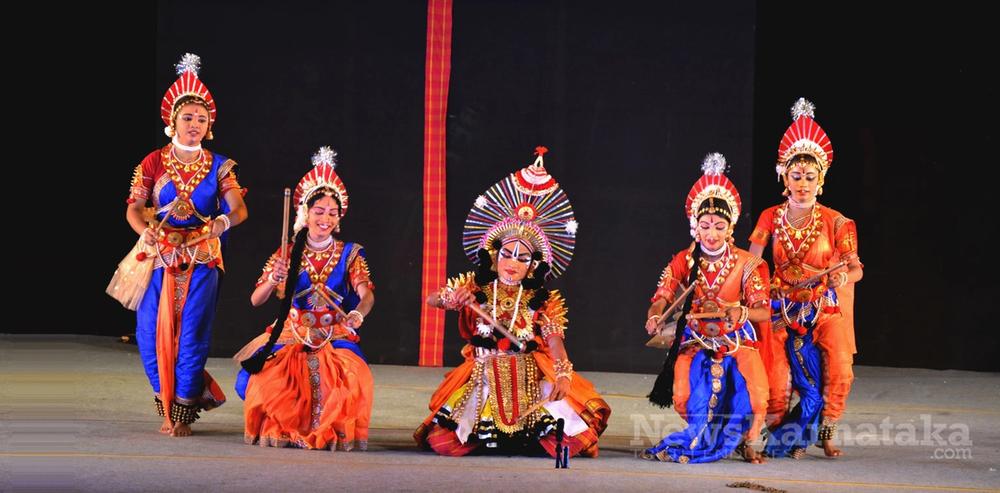The opening part of this series chiefly gives a sample of Muslim artistes in Ramlila, which goes by the story of a revered Hindu epic even as the lyrics are by a pivotal 16th-century bhakti poet. In this chapter, we look at an identical situation: of the involvement of Muslims in the rural Yakshagana theatre down the country.
The invocatory prayer to Lord Ganesha is customary to Yakshagana, but that doesn’t anymore deter Muslims from performing the art. In fact, the minority community these days has even a young woman doing roles that require a high-decibel voice besides a good amount of physical energy.
In February this year, the media went gaga about Arshiya Vitla, celebrating her power-packed performances as the fiery Mahishasura demon in the popular Devi Mahatme story-play. In her mid-20s, the artiste from Dakshina Kannada district is also winning applause for her male characters such as Raktha Beejasura and Nishambhasura. Arshiya loves her villainous roles, more so the entry part. She has performed in Udupi, Karwar and Belagavi besides
Mangalore, 40 km away from scenic Vitla along the Western Ghats. The girl first saw Yakshagana in school as a class-1 student and was particularly enchanted by Mahishasura. Three years later, she performed in the school’s anniversary celebrations by donning a minor role in amateur-level Yakshagana.
Past teenage, Arshiya began taking lessons under the renowned Ramesh Bhat of Kadali Kala Kendra. Today, she divides time between Yakshagana stages and as an employee in an automobile company. Currently, Arshiya is keen to learn two things around Yakshagana: the make-up and the chende drum.
There is Mohammed Ghouse, much elder to Arshiya. He has been performing for the past half-century. Brought up around Nellikatte in Kundapura, Ghouse’s family showed an attitude that was opposite to Arshiya’s. His parents wanted the boy to get rid of his passion for the art and, so, packed him off to the Gulf, where he landed a job. The youngster slogged in the deserts of Saudi Arabia for seven years, but eventually found his oasis back in his native Kavradi.
Today, integral to the Madamakki Veerabhadreshwara Yakshagana troupe, Ghouse does lead roles such as Veeramani, Bhasmasura, Jayanta and Arjuna.
Tala-Maddale veteran
Recently, Yakshagana lost a senior artiste. Jokatte Mohammed died on August 14, 2020, after having shone well also in the art of tala-maddale that employs the oral texts of Yaksagana, but as tools for sarcasm-riddled extempore debates between characters.
Mohammed had profound knowledge of both the Ramayana and the Mahabharatha, even as he excelled in the roles such as that of Dharmaraya, Bharatha and Karna at tala-maddale kootas. Old-timers recall how a stentorian voice enabled him to excel in doing characters in Yakshagana.
Another renowned Yakshagana artiste is Jabbar Samo of Sullia taluk. Much like with Arshiya, he was wooed to Yakshagana during his school days in Kallugundi off Sampaje, where many troupes would visit and present the art. Today, he has a stage experience of over 40 years.
Much junior to Samo, Yakshagana has Mohammed Ashfaq Hussain who has specialised in female roles. Showing promise in presenting well both the Thenku (southern) and Badagu (northern) styles of the form, the Moodbidri-based artiste in his twenties is already renowned for his roles as Lakshmi in Sudarshana Vijaya and Malini in Devi Mahatme.
Discordant notes & Foreign lands
Not everything has been hunky-dory for the artistes in this story. Arshiya, for instance, hasn’t received full support from her community. The saving grace for the youngster has been the family. Her parents, especially, are supportive. Their resistance has enabled her to overcome the hurdles her community keeps raising up her Yakshagana journey.
As for middle-aged Ghouse, too, his relatives avoided interacting with him in younger days. Still worse, marriage proposals for his sisters were turned away because they had a brother into a Hindu art. (It’s another matter the siblings did get their husbands and decent families.)
Coming to Ramlila, its Mumtaznagar troupe near UP’s Faizbad that flourished in a Muslim neighbourhood is facing survival issues. Eating meat has been sighted in recent years as a reason to bar them from playing key characters like Ram, Sita, Lakshman or Hanuman. (Hindus too are non-vegetarians; only that they give up meat during the Navratri celebrations.)
That said, even foreign countries with strong Indian population for centuries host Ramlila traditionally. Trinidad & Tobago, for example. Ramayana scholar Paula Richman has done a study on how Ramlila waned in the Caribbean islands since the 1980s, only to rebound by mid-1990s with topical improvisations. A 2010 article by Richman looks into English narration getting into the traditional Hindi verses and new ways of scriptwriting, besides freeing the art from restrictions based on gender and caste.
This is part 2 of a two-part series. Read Part 1 here.

